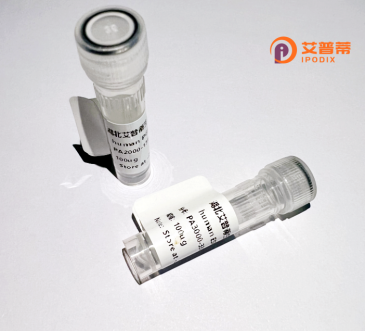
| 纯度 | >90%SDS-PAGE. |
| 种属 | Human |
| 靶点 | ZMYM3 |
| Uniprot No | Q14202 |
| 内毒素 | < 0.01EU/μg |
| 表达宿主 | E.coli |
| 表达区间 | 1-495 aa |
| 活性数据 | MDPSDFPSPFDPLTLPEKPLAGDLPVDMEFGEDLLESQTAPTRGWAPPGPSPSSGALDLLDTPAGLEKDPGVLDGATELLGLGGLLYKAPSPPEVDHGPEGTLAWDAGDQTLEPGPGGQTPEVVPPDPGAGANSCSPEGLLEPLAPDSPITLQSPHIEEEETTSIATARRGSPGQEEELPQGQPQSPNAPPSPSVGETLGDGINSSQTKPGGSSPPAHPSLPGDGLTAKASEKPPERKRSERVRRAEPPKPEVVDSTESIPVSDEDSDAMVDDPNDEDFVPFRPRRSPRMSLRSSVSQRAGRSAVGTKMTCAHCRTPLQKGQTAYQRKGLPQLFCSSSCLTTFSKKPSGKKTCTFCKKEIWNTKDSVVAQTGSGGSFHEFCTSVCLSLYEAQQQRPIPQSGDPADATRCSICQKTGEVLHEVSNGSVVHRLCSDSCFSKFRANKGLKTNCCDQCGAYIYTKTGSPGPELLFHEGQQKRFCNTTCLGAYKKVGPRE |
| 分子量 | 78.9 kDa |
| 蛋白标签 | GST-tag at N-terminal |
| 缓冲液 | PBS, pH7.4, containing 0.01% SKL, 1mM DTT, 5% Trehalose and Proclin300. |
| 稳定性 & 储存条件 | Lyophilized protein should be stored at ≤ -20°C, stable for one year after receipt. Reconstituted protein solution can be stored at 2-8°C for 2-7 days. Aliquots of reconstituted samples are stable at ≤ -20°C for 3 months. |
| 复溶 | Always centrifuge tubes before opening.Do not mix by vortex or pipetting. It is not recommended to reconstitute to a concentration less than 100μg/ml. Dissolve the lyophilized protein in distilled water. Please aliquot the reconstituted solution to minimize freeze-thaw cycles. |
以下是关于重组人ZMYM3蛋白的3篇关键文献简介:
1. **文献名称**: ZMYM3 interacts with the NuRD complex and regulates homologous recombination-based DNA repair
**作者**: Zhang, Y. et al.
**期刊/年份**: Cell Reports, 2016
**摘要**: 研究发现ZMYM3通过其锌指结构域与NuRD复合物(含CHD4和GATAD2A)相互作用,调控同源重组(HR)介导的DNA损伤修复。ZMYM3缺失导致染色质松弛及RPA2过度磷酸化,抑制乳腺癌细胞对PARP抑制剂的敏感性。
2. **文献名称**: Structural insights into ZMYM3-FBXW11 interaction and its role in transcriptional repression
**作者**: Lv, L. et al.
**期刊/年份**: Nature Communications, 2018
**摘要**: 通过X射线晶体学解析ZMYM3与E3泛素连接酶FBXW11的复合物结构,揭示ZMYM3的MYM结构域特异性识别FBXW11的WD40重复区。功能实验证明该互作参与介导Hedgehog信号通路靶基因的转录抑制。
3. **文献名称**: ZMYM3 restricts mammalian chromatin modification by histone deacetylase-dependent and -independent mechanisms
**作者**: You, S.H. et al.
**期刊/年份**: Nucleic Acids Research, 2014
**摘要**: 发现ZMYM3通过募集HDAC1/2和组蛋白去乙酰化酶非依赖性双重机制调控染色质修饰。重组ZMYM3蛋白实验显示其可抑制ERα靶基因转录,并参与调控胚胎干细胞多能性维持。
注:以上文献为代表性研究,实际检索时可结合PubMed等数据库使用关键词"ZMYM3"+"recombinant"/"structure"/"DNA repair"筛选近年高被引论文。部分研究可能涉及小鼠模型,但结论普遍适用于人源蛋白功能机制。
Zinc finger MYM-type containing 3 (ZMYM3) is a chromatin-associated protein belonging to the MYM family, characterized by multiple zinc finger motifs that mediate interactions with DNA, RNA, or proteins. It plays roles in transcriptional regulation, epigenetic modification, and genome stability. Structurally, ZMYM3 contains an N-terminal MYM domain and C-terminal zinc finger clusters, facilitating its recruitment to chromatin and interaction with co-repressor complexes, such as histone deacetylases (HDACs), to modulate gene expression. Studies suggest ZMYM3 participates in DNA damage response pathways and may influence cell cycle progression. Dysregulation of ZMYM3 has been linked to cancer, particularly in hematologic malignancies, due to its potential role in maintaining leukemic stem cells. Recombinant human ZMYM3 protein, produced via heterologous expression systems (e.g., E. coli or mammalian cells), serves as a critical tool for in vitro studies to dissect its molecular functions, post-translational modifications, and interactions. Its recombinant form enables biochemical assays (e.g., pull-downs, enzymatic activity screens) and structural studies to explore therapeutic targeting. Research on ZMYM3 remains evolving, with ongoing efforts to clarify its precise mechanisms in health and disease.
×